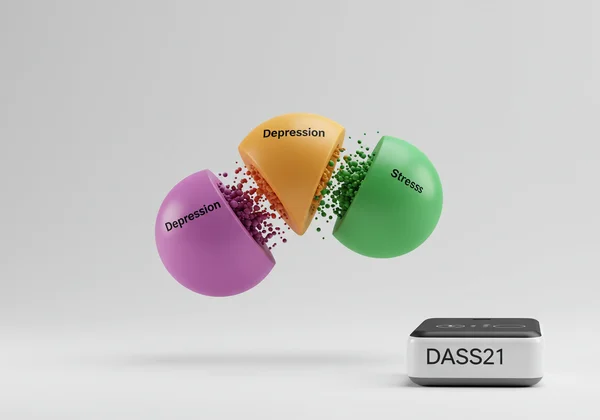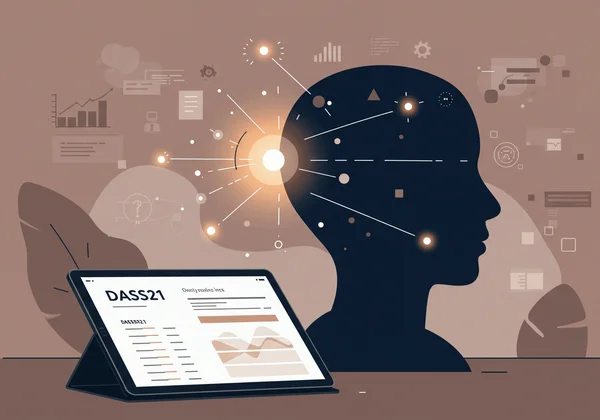DASS21 Subscales: Understanding Depression, Anxiety & Stress
Ever feel overwhelmed by your emotions, struggling to pinpoint what's truly going on? It's a common struggle. The feelings of sadness, worry, and stress often blend, making it hard to tell them apart. The DASS21 (Depression Anxiety Stress Scales 21) is a powerful, scientifically-backed tool designed to bring clarity to your emotional world. This guide will break down the three core subscales of the DASS21—Depression, Anxiety, and Stress—to reveal how this simple assessment can provide distinct, valuable insights into your mental well-being.
What is the DASS21 test, and how does it work? This self-assessment tool asks 21 questions about your experiences over the past week to help you differentiate these core emotional states. By understanding what each subscale measures, you can take a significant first step toward greater self-awareness. Ready to understand your feelings better? You can take the free DASS21 assessment in just a few minutes.

Deconstructing the DASS21: What Each Subscale Measures
The genius of the DASS21 lies in its ability to separate what often feels like a single tangled mess of negative emotions. Instead of giving you one generic "distress" score, it provides three separate scores, one for each subscale. This allows for a more nuanced understanding of your emotional state and helps identify which area might need the most attention. Let's explore what each scale specifically focuses on.

The Depression Subscale: Unpacking Low Mood & Anhedonia
The Depression subscale measures more than just sadness. It assesses a state of low positive affect, focusing on symptoms like persistent low mood, hopelessness, and a loss of interest or pleasure in activities you once enjoyed—a state known as anhedonia. It probes into feelings of worthlessness, self-disparagement, and a general lack of enthusiasm for life.
Questions related to this subscale help you reflect on whether you've been finding it difficult to work up the initiative to do things, felt that you had nothing to look forward to, or felt that life was meaningless. A higher score here points not just to sadness but to a deeper sense of disengagement and discouragement from life itself. Understanding this is the first step towards taking meaningful action, which can start with a confidential self-assessment.
The Anxiety Subscale: Understanding Physical & Cognitive Arousal
While anxiety and stress are often used interchangeably, the DASS21 Anxiety subscale hones in on a very specific experience: heightened physiological and cognitive arousal. This includes the physical symptoms many associate with fear, such as a racing heart, shortness of breath, trembling, or a dry mouth. It also assesses the psychological side of anxiety, like excessive worry and a subjective awareness of being panicked or flustered.
This subscale helps you identify if you've been overly aware of your own anxious feelings or have been worrying about panicking in front of others. By isolating these specific symptoms, the DASS21 helps you see whether your distress is linked to a state of persistent, fearful over-arousal. This clarity can be incredibly empowering and is available through our free DASS21 test.
The Stress Subscale: Identifying Tension, Irritability & Overload
The Stress subscale captures the feeling of being chronically over-aroused and tense, but it's distinct from the fear-based arousal of anxiety. It measures feelings of nervous tension, difficulty relaxing, irritability, and being easily agitated or "snappy." This is the scale that reflects feeling overwhelmed, impatient, and constantly on edge, as if your personal resources are being pushed to their limit.
If you've found yourself getting upset easily, being overly sensitive to interruptions, or feeling like you're using a lot of nervous energy, your score on this subscale may be elevated. Recognizing these signs of stress is crucial for preventing burnout. A quick check-in with the DASS21 can help you understand your scores and current stress levels.
Differentiating Emotional States: DASS21 for Clearer Emotional Assessment
Why does it matter if you can distinguish between depression, anxiety, and stress? Because while they can feel similar, they often benefit from different coping strategies and support systems. Misinterpreting chronic stress as depression, or anxiety as just a personality quirk, can lead to ineffective self-care and prolonged distress. The DASS21 provides a framework for a clearer emotional assessment, empowering you to respond more effectively to what you're truly feeling.
Why Distinct Measurement Matters for Your Well-being
Having distinct measurements helps you tailor your approach to mental wellness. For example, if your stress score is high but your depression score is low, your focus might be on setting boundaries, time management, and relaxation techniques. Conversely, if your depression score is high, your efforts might be better spent on re-engaging with hobbies, seeking social connection, and challenging negative self-talk.
Without this clarity, you might be trying to solve the wrong problem. The DASS21 acts like a compass, pointing you in the right direction for self-help or professional guidance. It moves you from a vague sense of "feeling bad" to a specific understanding of your emotional state. You can start your assessment today to gain this valuable insight.

Common Overlaps vs. Unique Indicators: A Closer Look
Many symptoms, such as difficulty sleeping or changes in appetite, can appear across all three states. This is where the DASS21 truly shines. By analyzing a pattern of 21 responses, it can identify the unique indicators that are more specific to each condition.
For example, while all three might cause agitation, the DASS21 differentiates the irritable, impatient agitation of stress from the fearful, panicky agitation of anxiety. It distinguishes the low energy of depression from the nervous, wired energy of stress. This nuanced approach helps untangle the emotional knot, giving you a clearer picture than you could get from simply guessing.
Empowering Your Self-Understanding with the DASS21 Assessment
The DASS21 is more than just a questionnaire; it's a powerful step toward taking control of your emotional well-being. It provides a private, accessible, and scientifically grounded way to check in with yourself. Taking a few minutes for a DASS21 assessment can be a profound act of self-care, providing the data you need to better navigate your inner world.
Gaining Clarity on Your Emotional Landscape
Think of your feelings as an internal landscape. Without a map, it's easy to get lost. The DASS21 provides that map. It helps you identify the mountains of stress, the valleys of depression, and the turbulent rivers of anxiety. With this map, you can navigate your emotional landscape with more confidence and purpose.
This clarity reduces the fear of the unknown. When you can name what you're feeling, it becomes less overwhelming and more manageable. It’s the difference between being lost in a storm and being able to identify the type of weather you need to prepare for. Begin charting your own map by visiting our DASS21 assessment page.

Guiding Your Next Steps in Mental Health
A DASS21 score is not an end point; it's a starting point. Your results can help you decide what to do next. A normal score can be reassuring, while an elevated score in one or more areas can be a gentle nudge to prioritize your mental health.
Your results can be a valuable tool for personal reflection, a guide for choosing self-help resources, or a concrete starting point for a conversation with a therapist, counselor, or doctor. It provides objective information that can help you advocate for yourself and seek the right kind of support.
Your Journey to Self-Awareness: Take Your DASS21 Assessment
Understanding the distinct nature of depression, anxiety, and stress is fundamental to effective emotional management. The DASS21 subscales offer a clear, structured way to gain that understanding. By separating these overlapping states, the tool empowers you with precise insights, helping you move from confusion to clarity.
Your journey to greater self-awareness is just a few clicks away. We invite you to take the test now to receive your confidential, instant results. It’s a free, simple, and powerful step toward taking charge of your mental well-being.
Frequently Asked Questions About DASS21 Subscales
What is the DASS21 test, and how does it work?
The DASS21 is a 21-question self-report scale designed to measure the severity of depression, anxiety, and stress symptoms over the past week. You answer each question on a 4-point scale, and the results are calculated to give you three separate scores. It’s a quick and reliable way to screen for these emotional states.
How do the DASS21 subscales differ from each other?
The Depression subscale measures low mood, hopelessness, and loss of pleasure. The Anxiety subscale measures physical and cognitive arousal, like panic and worry. The Stress subscale measures nervous tension, irritability, and feeling overwhelmed. While symptoms can overlap, each subscale targets a distinct emotional experience.
Is the DASS21 a diagnostic tool?
No, it is crucial to understand that the DASS21 is a screening tool, not a diagnostic instrument. It can indicate the presence and severity of symptoms, but it cannot provide a clinical diagnosis. For a formal diagnosis, you should always consult a qualified healthcare professional. You can use your results from our online tool as a starting point for that conversation.
Who can benefit from using the DASS21 assessment?
Anyone interested in better understanding their emotional health can benefit. This includes students feeling academic pressure, professionals managing work stress, individuals curious about their mood fluctuations, and even therapists looking for a quick screening tool for clients. It’s a versatile instrument for promoting self-awareness.